There are many reasons why you may not want to include all of your data in a Report. You may only want to see people who answer a specific question a certain way or data from a certain date range. You can do this using report filters.
Check out our Filter Export Data Tutorial to learn about Export filtering.

Filter a Standard Report
Filtering a Standard Report is easy as pie. You can filter by question answers, response status, response IDs and survey links. You can also create advanced filters with multiple conditions and/or groups of conditions. Finally, if you wish to filter by the date responses were recorded check out our Filter by Date Tutorial.

Filter By Question Answers
Use the By Question Answers option to add a condition based on the answer/s to a single question. You can add as many of these filters as you wish. They will be combined together with an AND operator.
Let's say, for example, that we wish to filter our report based on the following 2 questions in our survey:
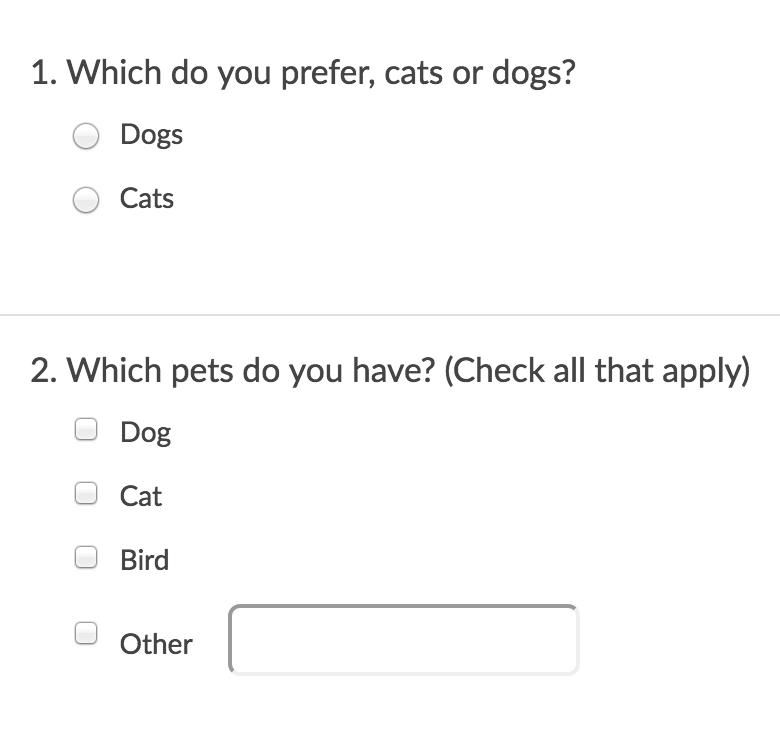
If for example, we wanted to see the survey results for respondents who prefer dogs and own a dog we would create two Question Answers filters.
- To get started we will click Filter > Add Filter > By Question Answers.

- In the first dropdown, we will select the question we wish to use in our logic condition.
- The second dropdown menu is your operator, which is populated by default based on the question type you selected.
- Finally, we will select the answer option that we wish to include in our logic rule and click Save Filter.
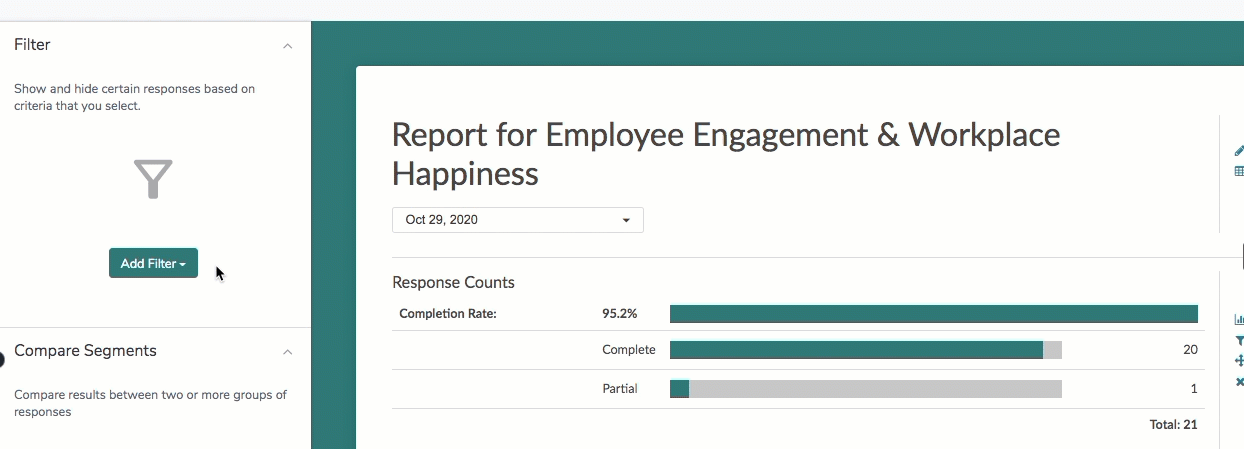
We will repeat these steps for the second question that we wish to include in our logic rule"Which pets do you have?" These two conditions will then be joined by an AND. So that we will only see results for people that prefer dogs AND have a dog.
If you wish to use a different joining operator other than AND use the option to Create Advanced Filter.
By Response Status
Each Standard Report will have a default filter based on the response Status. Reports will include Complete, Partial, Disqualified, and Test Data. You can customize this to include Deleted responses or exclude any of the statuses that are included by default.
- To do so, click Add Filter and select By Response Status. You will see the default options checked and can update the filter to better suit your needs.
- Click Save Filter when finished.

By Response IDs
Using both the Include the Following Response IDs and the Exclude the Following Response IDs fields you can filter to include or exclude specific response IDs.
- To set this up click Add Filter > By Response IDs and populate either or both the include or exclude fields. These values can be comma-separated and/or ranges can be specified.
- Make sure to Save Filter to apply this filter.
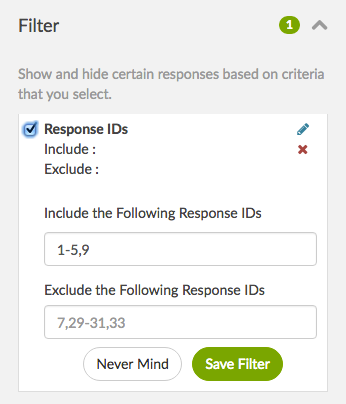
By Survey Link
If you have multiple share links (email campaigns, embeds, default web links, etc), you can filter by specific links.
Create Advanced Filter
This option gives you access to the logic builder you're likely pretty familiar with by the time you get to the reporting phase of your project. Using the logic builder you can set up logic conditions on questions in your survey and choose whether to join them with an AND or OR operator. You can also set up multiple conditions or groups of conditions. You can also filter based on geo data, URL variables, and email campaign contact data.
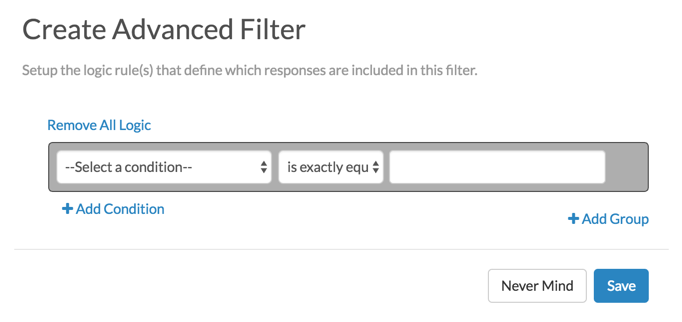
Add Conditions or Groups of Conditions
You can use the logic builder to add Conditions or Groups of conditions.
To add another Condition to your filter, click the +Add Condition below the first rule you've created. Additional rules can be used in conjunction with the existing rule (AND) or to create a separate exclusive condition (OR).
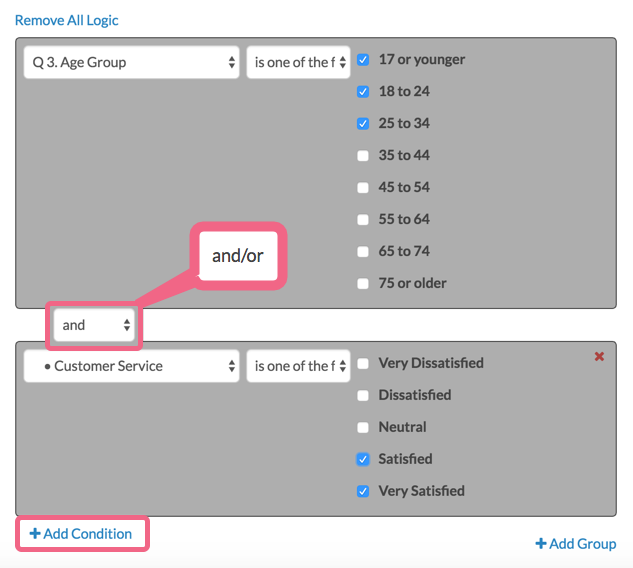
To add a new Group of Conditions, click +Add Group and create your rule(s) that can be used in conjunction with the first group or exclusively.
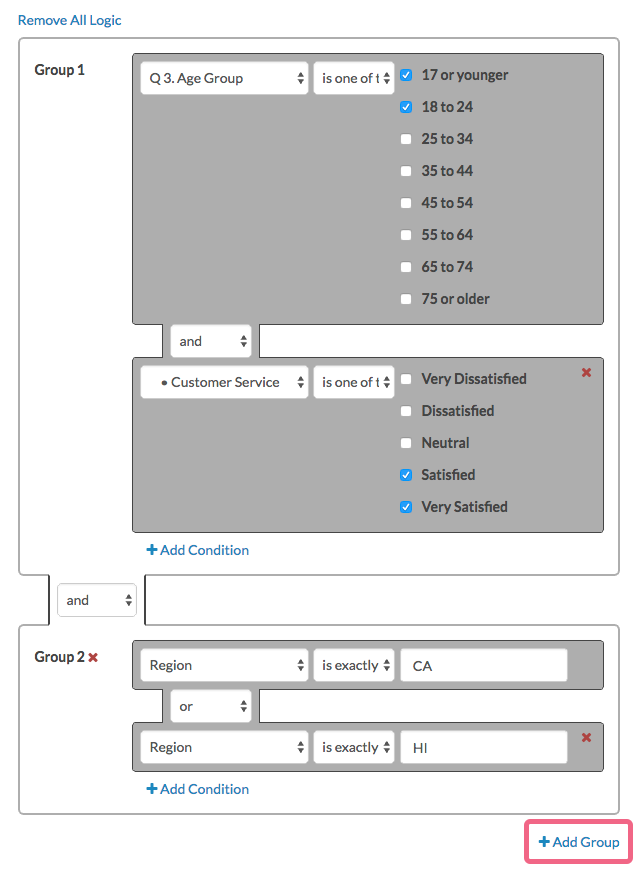
In the above example, the report would filter responses from respondents that said they were 17 or younger, 18 to 24 who were Satisfied or Very Satisfied with Customer Service who live in California or Hawaii.
What Does a Filtered Report Look Like?
It is important to note that filtering will only affect the data displayed within your report. Filtering will not affect which questions or answer options are displayed.
A default, unfiltered report will display all questions and all of the associated answer options along with the data. In the below example we are showing all responses.
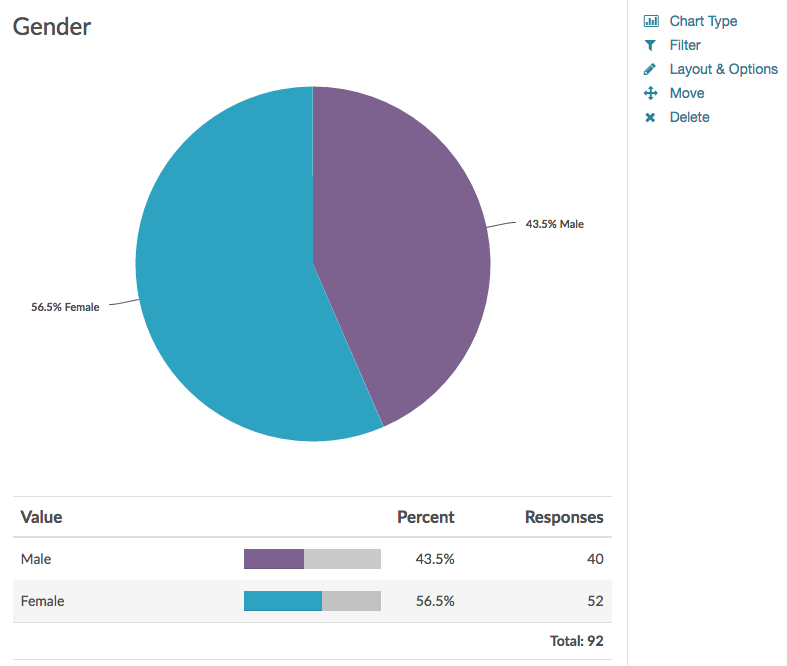
A filtered report will display all questions and all of the associated answer options but will only display the data according to your filter rules. In the below example, the report has been filtered to show data for those who selected 'male' as their gender, resulting in the following chart:

Filter All Other Report Types
Below are the steps to access the filtering options for the following report types: Summary Report, TURF Report, Cross Tab Report, Profile Report, Comparison Report.
- Go to Report and select your Summary Report.
- Click Customize Report > Filters.
What Can I Filter These Report Types By?
You can filter by a number of different options, as well as just about any question in your survey!
Response Status
Complete and Partial responses are included by default. You can modify to include Disqualified and Test responses.
Date Range
Filtering reports by a specific date range is a popular application of filters. You could set your report to filter by a specific range such as 12/1/2017 through 12/31/2017 (which would give you data between those dates).
You can also filter by a specific frequency of time such as -1 week, or -1 month. This means whenever you re-run your data, it would give you the latest week or month of data. Check out our Date Filtering Tutorial for examples.
Response IDs
Using both the Include Response IDs and the Exclude Response IDs fields you can filter to include or exclude specific response IDs.
By IP Address
This allows you to remove duplicate responses that were recorded from the same IP address. You can either keep the newest or oldest response.
Filter by Campaign
If you have multiple share links (email campaigns, embeds, default web links, etc), you can filter by specific links.
Filter Rules
This option allows you to filter by specific questions in your survey. You can also filter based on geo data, URL variables, and email campaign contact data.

Fields Not Available for Filtering
Option, Question, and Paged Piped questions cannot be used in filters.

